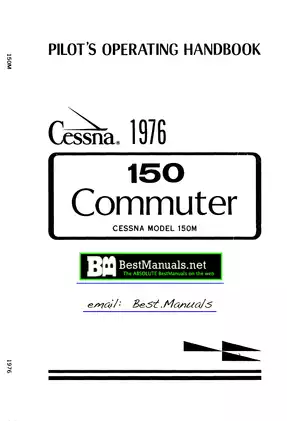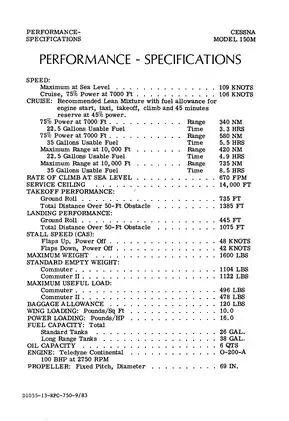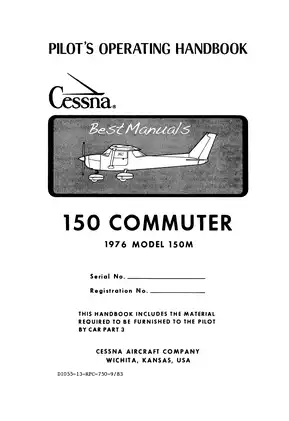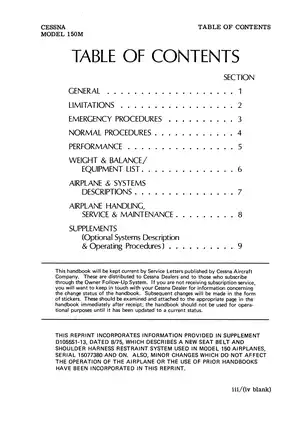Essential Reference: Cessna 150M (1976) - Comprehensive Guide
Product Gallery

Sample pages from the Essential Reference: Cessna 150M (1976) - Comprehensive Guide manual




Purchase Information
Cessna 150M Pilot's Operating Handbook - Technical Specifications
- Document Number / Seller:
- 25607 / Ronald Rodriguez
- File Size:
- 9.87 MB
- File Type:
- Language:
- English (some of our manuals are multi-language)
- Printable:
- Yes
- Estimated Download Time:
- 0.2 Minutes
- Delivery Format:
- Digital (PDF) - Instant Access
- Category:
- Aircraft
- Brand:
- Cessna
Cessna Models and Parts Covered in this Aircraft Manual
- Cessna 150M (1976)
Complete Manual Information
Cessna 150M Pilot's Operating Handbook
The Cessna 150M Pilot's Operating Handbook is an essential resource for every Cessna 150M owner and pilot. Comprehensive in scope, this manual provides detailed specifications, performance data, and operating procedures for the Cessna 150M aircraft. Whether you're a new owner or a seasoned pilot, this handbook will serve as an invaluable tool to ensure safe and efficient operation of your aircraft.
Key Features:
- Performance Specifications: Includes maximum speed, climb rates, fuel capacity, and range specifics for optimal flight planning.
- Operating Procedures: Step-by-step guidelines for normal operations, emergency procedures, and performance maneuvers.
- Emergency Protocols: Detailed emergency procedures for various scenarios, including engine failures, forced landings, and other critical situations.
Detailed Table of Contents
The manual is organized into the following sections:
- Section 1: General Information
- Section 2: Limitations
- Section 3: Emergency Procedures
- Section 4: Normal Procedures
- Section 5: Performance Data
- Section 6: Weight and Balance
- Section 7: Airplane and Systems Descriptions
- Section 8: Handling, Service & Maintenance
- Section 9: Supplements and Additions
What's Inside:
- Specifications: Get the most accurate data regarding your Cessna's capabilities, including weight limits and fuel capacities.
- Flight Control System: An in-depth look at the flight control systems including trim and control lock information.
- Systems Overview: Understand the avionics, fuel system, and engine specifications that influence performance and operational safety.
- Maintenance Guidelines: Recommendations for regular maintenance practices to keep the aircraft in airworthy condition.
- Towing and Ground Handling Procedures: Instructions on how to safely tow and park your aircraft, ensuring safety and maintenance of the airframe.
This handbook is your ticket to mastering the Cessna 150M, enhancing your flying experience while ensuring compliance with aviation standards and safety protocols
Download Instructions for Cessna Aircraft Manual
Frequently Asked Questions - Cessna Aircraft Manual
What does this Cessna manual cover?
This comprehensive service manual covers detailed repair procedures, maintenance schedules, troubleshooting guides, and technical specifications for Essential Reference: Cessna 150M (1976) - Comprehensive Guide. It includes information for the following models: - Cessna 150M (1976).
Is this manual suitable for beginners?
Yes, this Cessna manual is designed for both professional technicians and DIY enthusiasts. It includes step-by-step procedures with clear illustrations and safety guidelines for Aircraft maintenance and repair.
What file format will I receive?
You will receive this manual as a PDF file (9.87 MB), which is compatible with all devices. The manual is fully searchable and printable for your convenience.
How quickly can I access the manual after purchase?
You'll receive instant access to your Cessna Aircraft manual immediately after payment completion. The download link is valid for 3 days, with lifetime re-download guarantee.
Can I print specific sections of the manual?
Absolutely! This digital manual allows you to print any section you need, from individual pages to complete chapters, making it perfect for workshop use.
Customer Reviews and Feedback
Read what our customers say about this Cessna Aircraft manual and share your own experience.
Add Comment
This policy contains information about your privacy. By posting, you are declaring that you understand this policy:
- Your name, rating, website address, town, country, state and comment will be publicly displayed if entered.
- Aside from the data entered into these form fields, other stored data about your comment will include:
- Your IP address (not displayed)
- The time/date of your submission (displayed)
- Your email address will not be shared. It is collected for only two reasons:
- Administrative purposes, should a need to contact you arise.
- To inform you of new comments, should you subscribe to receive notifications.
- A cookie may be set on your computer. This is used to remember your inputs. It will expire by itself.
This policy is subject to change at any time and without notice.
These terms and conditions contain rules about posting comments. By submitting a comment, you are declaring that you agree with these rules:
- Although the administrator will attempt to moderate comments, it is impossible for every comment to have been moderated at any given time.
- You acknowledge that all comments express the views and opinions of the original author and not those of the administrator.
- You agree not to post any material which is knowingly false, obscene, hateful, threatening, harassing or invasive of a person's privacy.
- The administrator has the right to edit, move or remove any comment for any reason and without notice.
Failure to comply with these rules may result in being banned from submitting further comments.
These terms and conditions are subject to change at any time and without notice.
Comments (2)